Abstract
We have reviewed randomised controlled trials of physical activity promotion to provide recent and reliable information on the effectiveness of physical activity promotion. Computerised databases and references of references were searched. Experts were contacted and asked for information about existing work. Studies assessed were randomised controlled trials of healthy, free living, adult subjects, where exercise behaviour was the dependent variable. Eleven trials were identified. No United Kingdom based studies were found. Interventions that encourage walking and do not require attendance at a facility are most likely to lead to sustainable increases in overall physical activity. Brisk walking has the greatest potential for increasing overall activity levels of a sedentary population and meeting current public health recommendations. The small number of trials limits the strength of any conclusions and highlights the need for more research.
Full text
PDF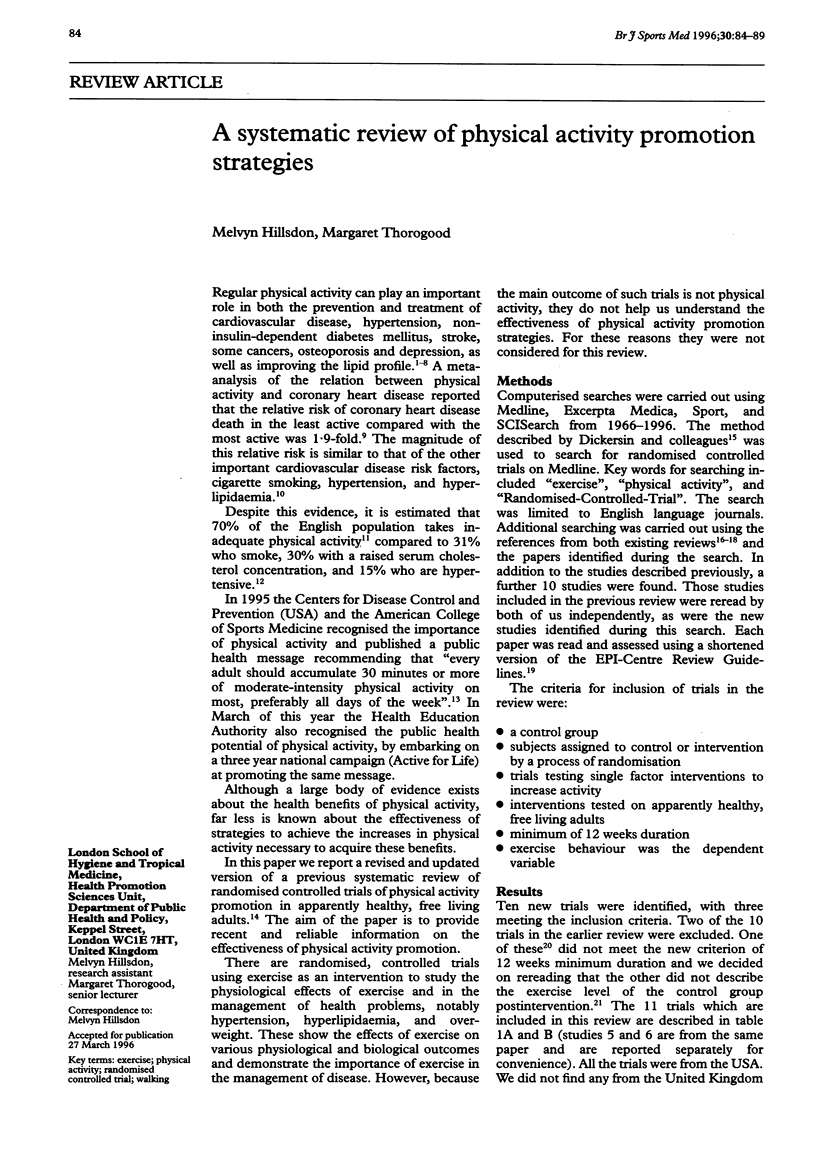
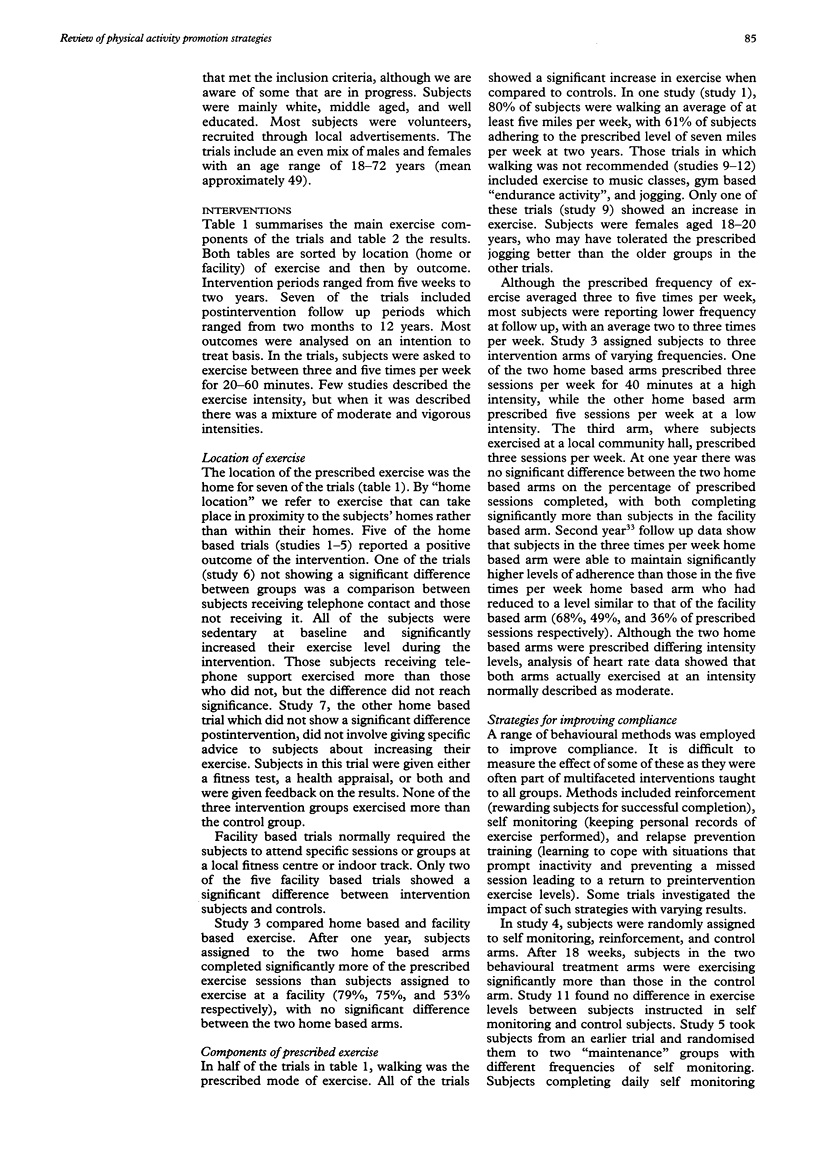
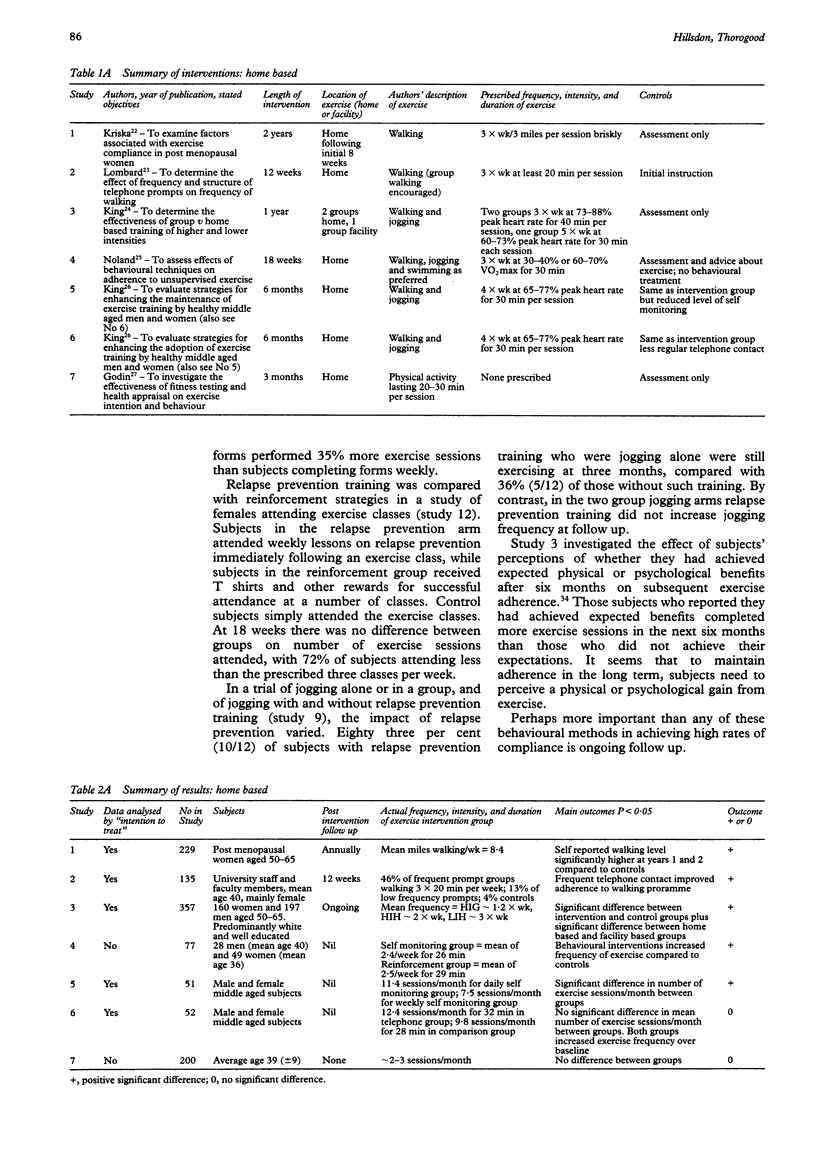
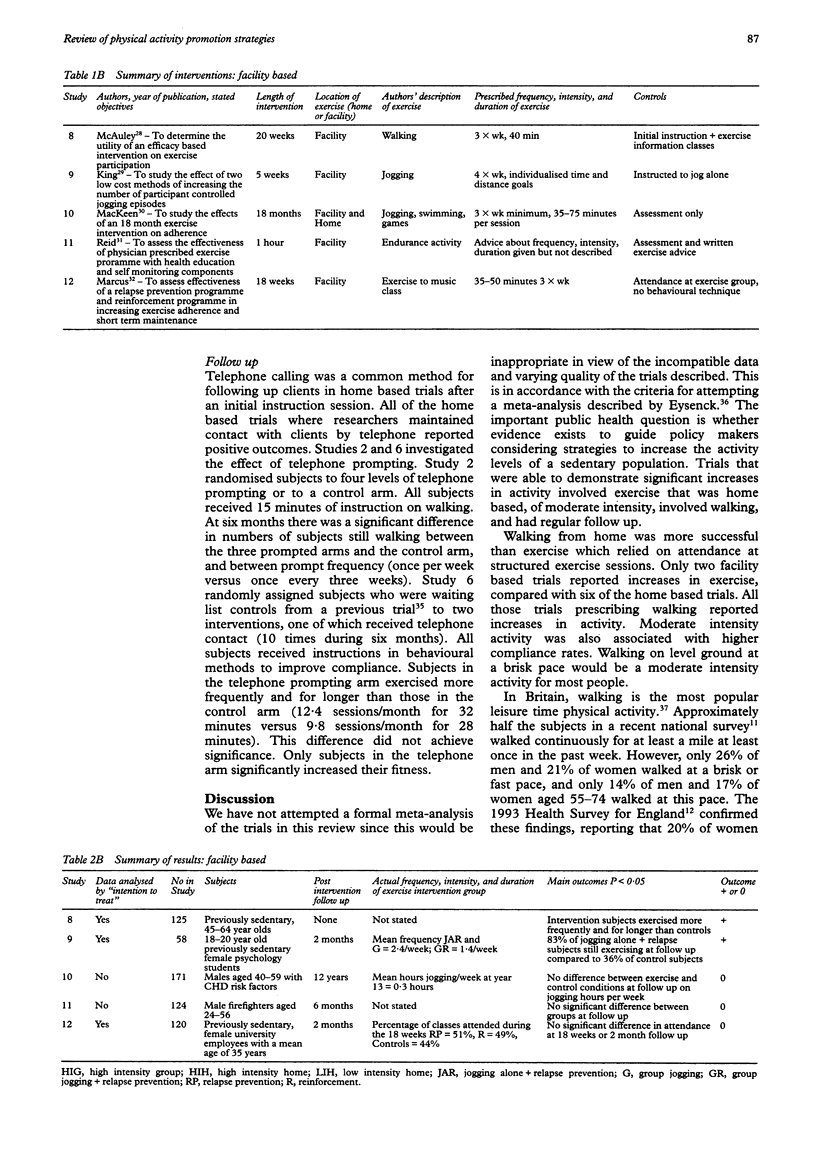
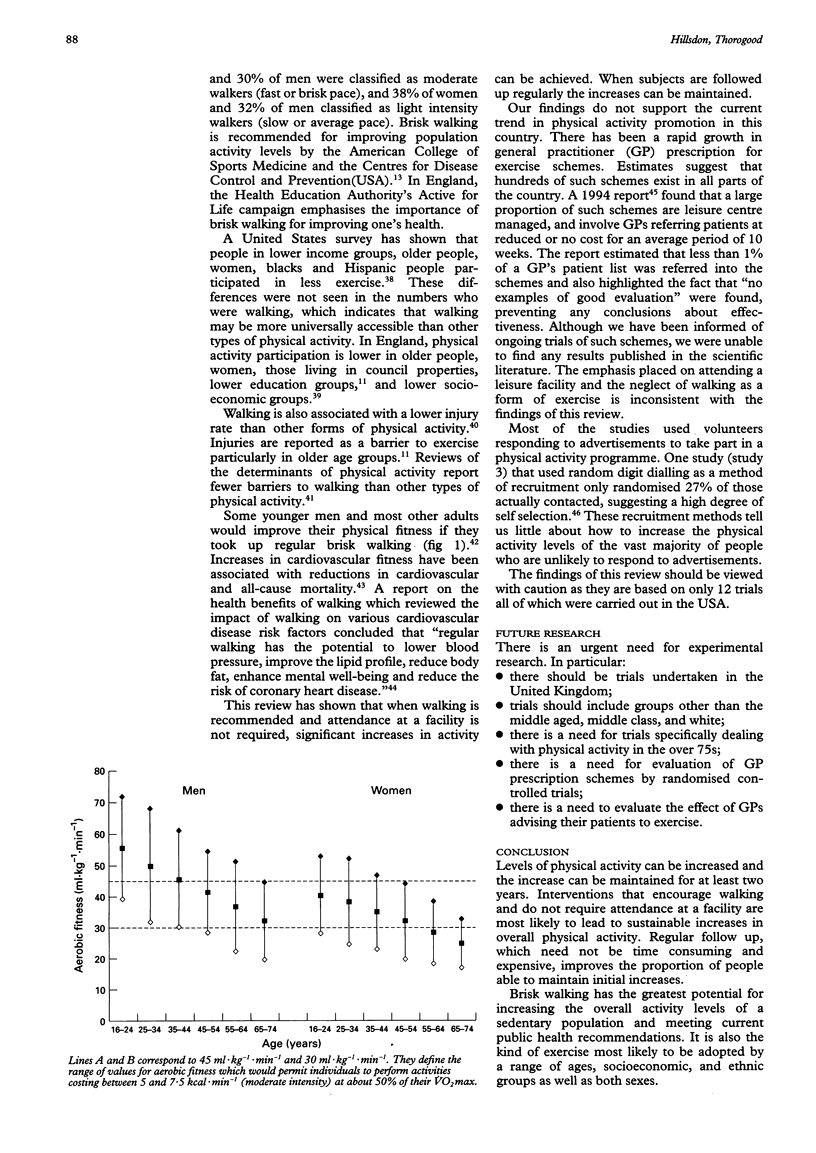
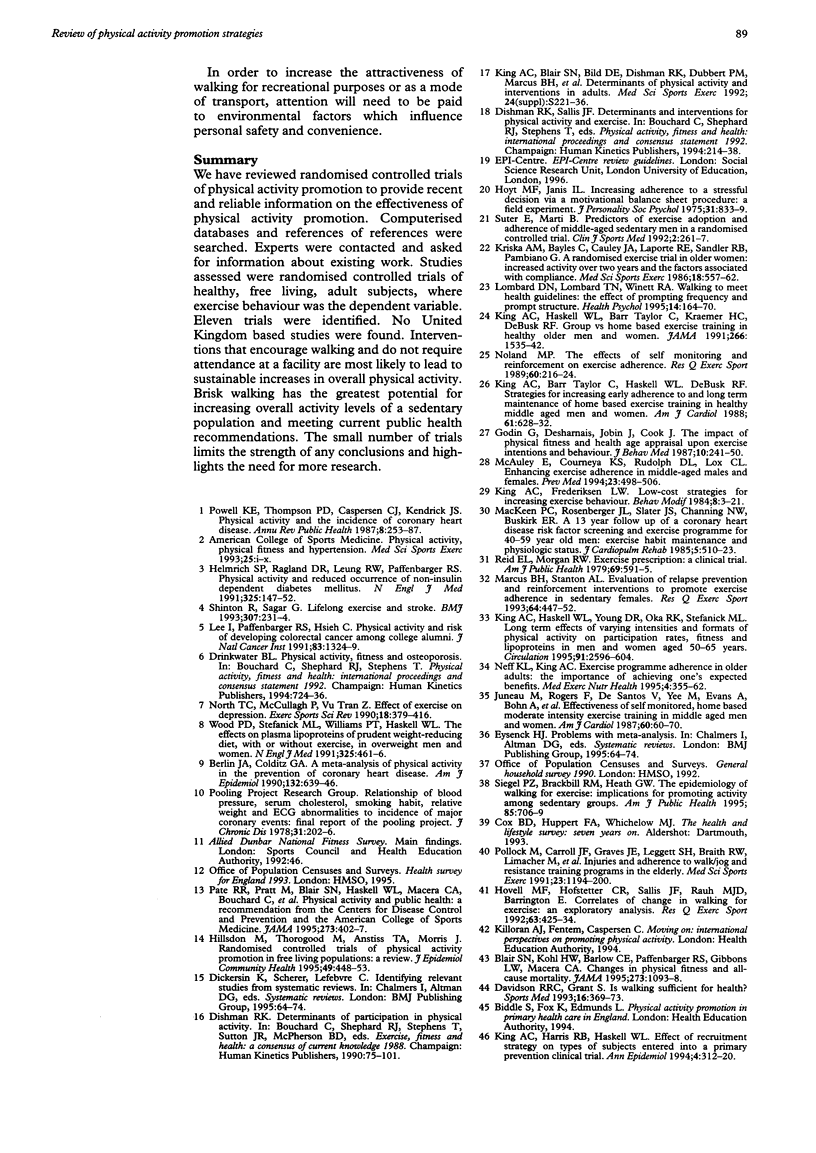
Selected References
These references are in PubMed. This may not be the complete list of references from this article.
- Blair S. N., Kohl H. W., 3rd, Barlow C. E., Paffenbarger R. S., Jr, Gibbons L. W., Macera C. A. Changes in physical fitness and all-cause mortality. A prospective study of healthy and unhealthy men. JAMA. 1995 Apr 12;273(14):1093–1098. [PubMed] [Google Scholar]
- Davison R. C., Grant S. Is walking sufficient exercise for health? Sports Med. 1993 Dec;16(6):369–373. doi: 10.2165/00007256-199316060-00002. [DOI] [PubMed] [Google Scholar]
- Godin G., Desharnais R., Jobin J., Cook J. The impact of physical fitness and health-age appraisal upon exercise intentions and behavior. J Behav Med. 1987 Jun;10(3):241–250. doi: 10.1007/BF00846538. [DOI] [PubMed] [Google Scholar]
- Hillsdon M., Thorogood M., Anstiss T., Morris J. Randomised controlled trials of physical activity promotion in free living populations: a review. J Epidemiol Community Health. 1995 Oct;49(5):448–453. doi: 10.1136/jech.49.5.448. [DOI] [PMC free article] [PubMed] [Google Scholar]
- Hovell M. F., Hofstetter C. R., Sallis J. F., Rauh M. J., Barrington E. Correlates of change in walking for exercise: an exploratory analysis. Res Q Exerc Sport. 1992 Dec;63(4):425–434. doi: 10.1080/02701367.1992.10608765. [DOI] [PubMed] [Google Scholar]
- Juneau M., Rogers F., De Santos V., Yee M., Evans A., Bohn A., Haskell W. L., Taylor C. B., DeBusk R. F. Effectiveness of self-monitored, home-based, moderate-intensity exercise training in middle-aged men and women. Am J Cardiol. 1987 Jul 1;60(1):66–70. doi: 10.1016/0002-9149(87)90986-6. [DOI] [PubMed] [Google Scholar]
- King A. C., Blair S. N., Bild D. E., Dishman R. K., Dubbert P. M., Marcus B. H., Oldridge N. B., Paffenbarger R. S., Jr, Powell K. E., Yeager K. K. Determinants of physical activity and interventions in adults. Med Sci Sports Exerc. 1992 Jun;24(6 Suppl):S221–S236. [PubMed] [Google Scholar]
- King A. C., Harris R. B., Haskell W. L. Effect of recruitment strategy on types of subjects entered into a primary prevention clinical trial. Ann Epidemiol. 1994 Jul;4(4):312–320. doi: 10.1016/1047-2797(94)90087-6. [DOI] [PubMed] [Google Scholar]
- King A. C., Haskell W. L., Taylor C. B., Kraemer H. C., DeBusk R. F. Group- vs home-based exercise training in healthy older men and women. A community-based clinical trial. JAMA. 1991 Sep 18;266(11):1535–1542. [PubMed] [Google Scholar]
- King A. C., Haskell W. L., Young D. R., Oka R. K., Stefanick M. L. Long-term effects of varying intensities and formats of physical activity on participation rates, fitness, and lipoproteins in men and women aged 50 to 65 years. Circulation. 1995 May 15;91(10):2596–2604. doi: 10.1161/01.cir.91.10.2596. [DOI] [PubMed] [Google Scholar]
- King A. C., Taylor C. B., Haskell W. L., Debusk R. F. Strategies for increasing early adherence to and long-term maintenance of home-based exercise training in healthy middle-aged men and women. Am J Cardiol. 1988 Mar 1;61(8):628–632. doi: 10.1016/0002-9149(88)90778-3. [DOI] [PubMed] [Google Scholar]
- Kriska A. M., Bayles C., Cauley J. A., LaPorte R. E., Sandler R. B., Pambianco G. A randomized exercise trial in older women: increased activity over two years and the factors associated with compliance. Med Sci Sports Exerc. 1986 Oct;18(5):557–562. [PubMed] [Google Scholar]
- Lee I. M., Paffenbarger R. S., Jr, Hsieh C. Physical activity and risk of developing colorectal cancer among college alumni. J Natl Cancer Inst. 1991 Sep 18;83(18):1324–1329. doi: 10.1093/jnci/83.18.1324. [DOI] [PubMed] [Google Scholar]
- Lombard D. N., Lombard T. N., Winett R. A. Walking to meet health guidelines: the effect of prompting frequency and prompt structure. Health Psychol. 1995 Mar;14(2):164–170. doi: 10.1037//0278-6133.14.2.164. [DOI] [PubMed] [Google Scholar]
- Marcus B. H., Stanton A. L. Evaluation of relapse prevention and reinforcement interventions to promote exercise adherence in sedentary females. Res Q Exerc Sport. 1993 Dec;64(4):447–452. doi: 10.1080/02701367.1993.10607598. [DOI] [PubMed] [Google Scholar]
- McAuley E., Courneya K. S., Rudolph D. L., Lox C. L. Enhancing exercise adherence in middle-aged males and females. Prev Med. 1994 Jul;23(4):498–506. doi: 10.1006/pmed.1994.1068. [DOI] [PubMed] [Google Scholar]
- Noland M. P. The effects of self-monitoring and reinforcement on exercise adherence. Res Q Exerc Sport. 1989 Sep;60(3):216–224. doi: 10.1080/02701367.1989.10607443. [DOI] [PubMed] [Google Scholar]
- North T. C., McCullagh P., Tran Z. V. Effect of exercise on depression. Exerc Sport Sci Rev. 1990;18:379–415. [PubMed] [Google Scholar]
- Pate R. R., Pratt M., Blair S. N., Haskell W. L., Macera C. A., Bouchard C., Buchner D., Ettinger W., Heath G. W., King A. C. Physical activity and public health. A recommendation from the Centers for Disease Control and Prevention and the American College of Sports Medicine. JAMA. 1995 Feb 1;273(5):402–407. doi: 10.1001/jama.273.5.402. [DOI] [PubMed] [Google Scholar]
- Pollock M. L., Carroll J. F., Graves J. E., Leggett S. H., Braith R. W., Limacher M., Hagberg J. M. Injuries and adherence to walk/jog and resistance training programs in the elderly. Med Sci Sports Exerc. 1991 Oct;23(10):1194–1200. [PubMed] [Google Scholar]
- Powell K. E., Thompson P. D., Caspersen C. J., Kendrick J. S. Physical activity and the incidence of coronary heart disease. Annu Rev Public Health. 1987;8:253–287. doi: 10.1146/annurev.pu.08.050187.001345. [DOI] [PubMed] [Google Scholar]
- Shinton R., Sagar G. Lifelong exercise and stroke. BMJ. 1993 Jul 24;307(6898):231–234. doi: 10.1136/bmj.307.6898.231. [DOI] [PMC free article] [PubMed] [Google Scholar]
- Siegel P. Z., Brackbill R. M., Heath G. W. The epidemiology of walking for exercise: implications for promoting activity among sedentary groups. Am J Public Health. 1995 May;85(5):706–710. doi: 10.2105/ajph.85.5.706. [DOI] [PMC free article] [PubMed] [Google Scholar]
- Wood P. D., Stefanick M. L., Williams P. T., Haskell W. L. The effects on plasma lipoproteins of a prudent weight-reducing diet, with or without exercise, in overweight men and women. N Engl J Med. 1991 Aug 15;325(7):461–466. doi: 10.1056/NEJM199108153250703. [DOI] [PubMed] [Google Scholar]


